Nemo and the Zombie Anemone
Written by Alison Barrat
Comparing a bleached anemone to the undead may be a bit of a stretch, but it is fair to say a bleached anemone is hovering somewhere between life and death and depending on what happens next, it can go either way.
We got a closer look at the phenomenon of bleached anemones earlier this year during a research mission in the British Indian Ocean Territory. When we arrived in this massive Marine Protected Area (MPA) we saw thousands of corals competing for reef space in the shallow water. Sponges dotted the nooks and crannies of the reef and anemones clung to the open reef their tentacles dancing back and forth with the waves. Thousands upon thousands of glittering fish filled the surrounding blue water. It was the kind of reef we had dreamed of seeing during our Global Reef Expedition.
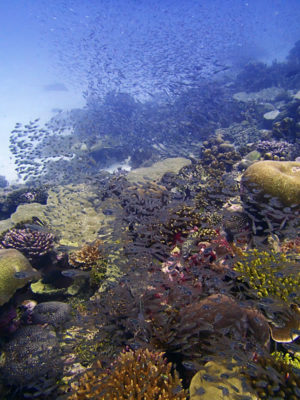
Warm, sunny days with little wind made the diving easy, but the hot temperatures and calm seas we were enjoying belied their real impact. The ocean began to heat up. For stationary creatures of the reef, like corals and anemones, there is no escape from the rising temperature and excess light. In response, they begin to transform.
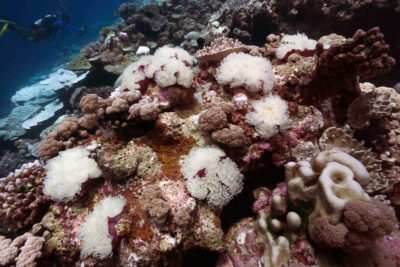
Coral bleaching may be more familiar than anemone bleaching, but these two processes are nearly identical. Some anemones host algae inside their bodies which gives them their color, both the anemone and the algae benefit from their partnership. The anemone provides the algae with carbon dioxide and other nutrients that they need to live, and in return the algae provide the anemone with oxygen and food like glycerol that the anemone needs. But this happy co-existence breaks down when the surrounding water gets too hot or when the anemones get exposed to too much light. Then the algae are expelled, or leave on their own, and the anemones become colorless and bleached white.
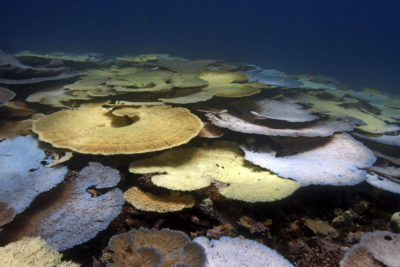
But some anemones have more than one symbiotic relationship. As well as sharing their body tissues with algae, these anemones share their tentacles with anemonefish (e.g. clown fish). Sea anemones thrive in warm tropical waters on shallow reefs, home to hundreds of species of fish, some of which would quite like to eat a tasty chunk of anemone. Studies have shown that the clownfish may protect the anemone against predatory bites from butterflyfish. And, they can help the anemone in other ways like keeping it clean by removing debris or their waste may even supply some nutrients to the anemone. Studies also suggest that hosting a clownfish allowed certain anemones to evolve a larger diameter, which in turn created a large surface area for the algae to receive more light. The anemone, the algae, and the clown fish all benefit from the partnership.
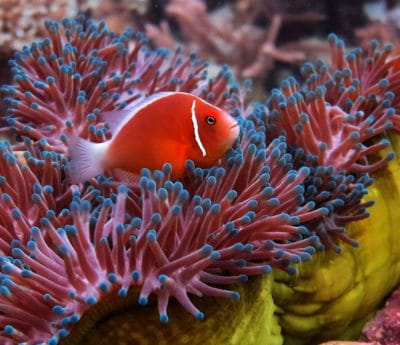
The advantages to the anemone fish are fairly obvious; the anemone provides the fish with a home where it lives under the protection of the anemones many stinging tentacles. When anemones and clownfish live together they depend on each other for survival. Without a host anemone most clown fish very quickly die on the reef, picked off by larger predatory fish.
As the water of the British Indian Ocean Territory kept warming, we watched as some corals went through a rainbow transformation becoming multicolored, some continued to look healthy and others turned a bleached white. The anemones faded into a colorless existence, their ghostly tentacles waving in the current while the brilliantly colored anemonefish stuck with their ailing partner. Our research mission ended before the water temperature cooled and we were left with this faded image of BIOT’s reefs.
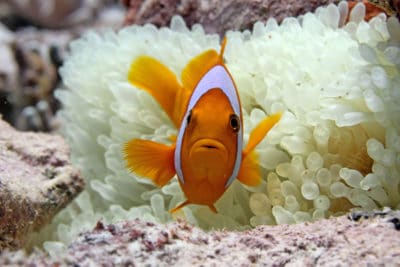
Because anemones get most of their nutrition from plankton and small fish, rather than symbiotic algae, many of them can survive bleaching if the water temperature goes back down, but studies show that their body size may shrink by over a quarter after they have bleached. Anemonefish living with them will similarly endure the bleaching, but produce fewer eggs the following year. As we face more bleaching this year, and the promise of more in the future if our ocean temperatures keep rising, we know that it is not only the corals that suffer during rising ocean temperatures. Bleaching diminishes the reef in ways that we are just beginning to understand reducing the overall health and sustainability of the entire ecosystem.
This article first appeared in National Geographic Voices